#Giant turtle shell fossil
Explore tagged Tumblr posts
Photo

RARE: Giant Turtle Shell Fossil – Large Section, Cretaceous, Australia
This listing offers a rare and substantial fossil section of a giant turtle shell, dating to the Cretaceous Period, and originating from Australia. This is a large carapace (shell) fragment, representing a prehistoric marine or freshwater turtle that lived during the age of the dinosaurs.
Fossil Type:
Specimen: Turtle Shell Fossil (Carapace Section)
Likely from a large cryptodiran turtle based on structural and regional indicators
Geological Context:
Period: Cretaceous
Estimated Age: ~100–66 million years ago (exact stage unspecified due to locality constraints)
Depositional Environment: Likely fluvial or marginal marine settings; turtles during this time inhabited both freshwater rivers and coastal marine lagoons
Preservation: Mineral replacement of original shell bone; stable and consolidated, with visible scute impressions or bone texture in many specimens
Morphological Features:
Broad, gently curved shell fragment from the carapace (top of the shell)
Possible preserved sutures between scutes (the bony plates of the shell)
Textured surface consistent with dermal ossifications of large Cretaceous turtles
Dense, heavy fossilised bone with natural weathering and coloration
Scientific Importance:
Turtle fossils from the Cretaceous of Australia are rare and often fragmentary, making this large, intact section particularly desirable for collectors or research reference
Contributes to the understanding of turtle diversity in Gondwanan continents during the Mesozoic era
May be associated with genera such as Notochelone, Bouliachelys, or other large extinct marine cryptodires depending on region
Locality Information:
Australia – Specific site undisclosed, but Cretaceous turtle remains are known from deposits in Queensland and New South Wales, especially in areas formerly covered by inland seas and floodplains
Authenticity & Display:
All of our fossils are 100% Genuine Specimens and are supplied with a Certificate of Authenticity. The photographs in the listing show the actual fossil specimen you will receive. Please refer to the image for full sizing, with the scale cube = 1cm.
This is a rare opportunity to acquire a genuine, large fragment of a Cretaceous turtle shell from Australia. Perfect for fossil collectors, vertebrate palaeontology enthusiasts, or natural history displays.
Add a striking and scientifically valuable fossil to your collection—an authentic relic of the ancient Cretaceous ecosystems of prehistoric Australia.
#Giant turtle shell fossil#Cretaceous turtle fossil#Australian fossil turtle#fossil carapace section#rare turtle fossil for sale#large turtle shell bone#prehistoric turtle fossil Australia#certified fossil turtle#fossil reptile shell#authentic turtle fossil specimen
1 note
·
View note
Text
#2829 - Psephophorus terryprachetti - Pterry's Giant Pturtle

A very large, extinct, leatherback turtle from the Eocene, named after beloved author Terry Pratchett. He was pleased about this, saying that anybody that wasn't delighted about getting a species named after them was clearly a Pod being from the Planet Zog.
The first fossils from the genus were discovered by German Paleontologist Christian Erich Hermann von Meyer in 1846, but all he had were the dermal plates (not that different from the fossil above, really). That's probably why even by 1879, they still weren't clear on what it actually was - British paleotologist Harry Govier Seeley thought they resembled the armour of an armadillo.
The Pturtle was discovered in New Zealand in the 1990s. It would have been 2.5m long, in life.
Sadly, there's only one Dermochelyid turtle left in the world - the Leatherback Dermochelys coriacea, which is critically endangered in some areas. Leatherbacks are unique compared to other modern sea turtles because they lack a bony shell; instead, its carapace is covered by oily flesh and flexible, leathery skin. They're also the deepest-diving and fastest reptiles in the world, swimming down to over 1200m depth, at speeds of up to 35kph. Their constant activity and internal adaptations lets them run at a surprisingly high internal temperature - 18C above the surrounding water.
The biggest threat to leatherback survival is, unfortunately, humanity - hatchlings can be confused by artificial light and head inland instead of towards the water, older turtles are easily caught in fishing nets, and they can confuse plastic bags floating in the water for the jellyfish that form the bulk of their diet.
Otago Museum, Dunedin, Aotearoa New Zealand.
#Otago Museum#Dunedin#Dermochelyidae#Psephophorus#leatherback turtle#new zealand fossil#fossil turtle#terry pratchett#great a'tuin
210 notes
·
View notes
Text
Crystal Palace Field Trip Part 1: Walking With Victorian Monsters
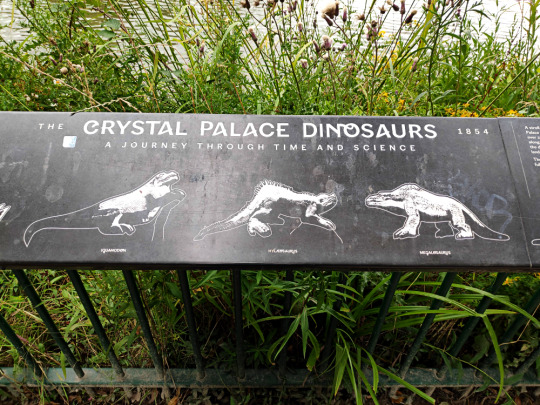
The Crystal Palace Dinosaurs take their name from the original Crystal Palace, a glass-paned exhibition building originally constructed for a World's Fair in Hyde Park in 1851.
In 1854 the structure was relocated 14km (~9 miles) south to the newly-created Crystal Palace Park, and a collection of over 30 life-sized statues of prehistoric animals were commissioned to accompany the reopening – creating a sort of Victorian dinosaur theme park – sculpted by Benjamin Waterhouse Hawkins with consultation from paleontologist Sir Richard Owen.
The Palace building itself burned down completely in 1936, and today only the ruins of its terraces remain in the northeast of the park grounds.

The Crystal Palace building then and now Left image circa 1854 (public domain) Right image circa 2011 by Mark Ahsmann (CC BY-SA 3.0)
Six sphinx statues based on the Great Sphinx of Tanis also survive up among the Palace ruins, flanking some of the terrace staircases. They fell into serious disrepair during the latter half of the 20th century, but in 2017 they all finally got some much-needed preservation work, repairing them and restoring their original Victorian red paint jobs.

———
…But let's get to what we're really here for. Dinosaurs! (…And assorted other prehistoric beasties!)
The "Dinosaur Court" down in the south end of the park still remains to this day, displayed across several islands in a man-made lake. Over the decades they've been through multiple cycles of neglect and renovation, and are currently cared for by the London Borough of Bromley (Crystal Palace Park Trust are due to take over custodial duties in September 2023), with promotion and fundraising assistance from organizations like Historic England and the Friends of the Crystal Palace Dinosaurs charity.
Just about 170 years old now, the Crystal Palace Dinosaurs represent fifteen different types of fossil creatures known to 1850s Victorian science, with only three actual dinosaur species featured. Although often derided for being outdated and very inaccurate by modern standards, they were actually incredibly good efforts at the time, especially taking into account that the field of paleontology was still in its very early days.
They also just have a lot of charm, with toothy grins and surprisingly dynamic poses.
Unfortunately on the day I visited in early August 2023 most of the statues were heavily obscured by plant growth, both on their islands and on the sides of the paths they can usually be viewed from. Since I'd seen images from about a month ago showing things being less overgrown, this was probably just some unlucky timing on my part coinciding with some explosive summer foliage growth.
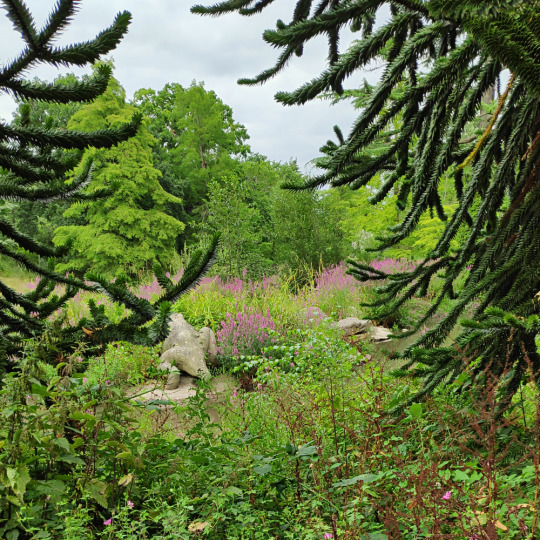
The first island on the trail features a few Permian and Triassic animals which were only known from fragmentary remains in the 1850s. These "labyrinthodonts" were recognized as having similarities to both amphibians and reptiles, and so were depicted with boxy toothy jaws, warty skin, stumpy tails, and long frog-like back legs.
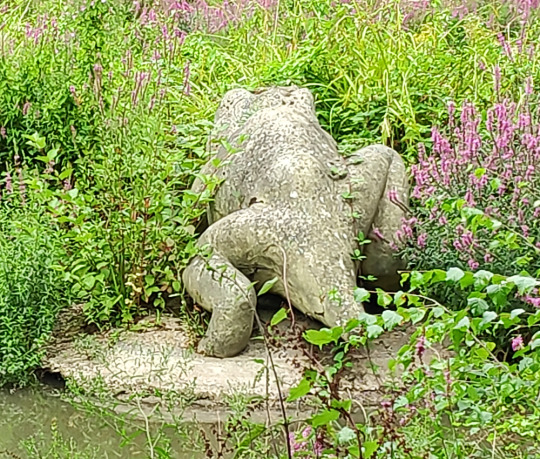
Today we'd call these particular animals temnospondyl amphibians, specifically Mastodonsaurus, and we know they were actually shaped more like giant salamanders with longer flatter crocodilian-like jaws, smaller legs, and long paddle-like tails.

———

Somewhere in the foliage beyond this specific "labyrinthodont" there was also supposed to be a pair of dicynodonts, but I couldn't see much of them at all and didn't manage to get a remotely visible photograph.
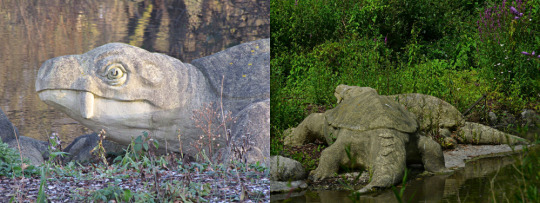
Crystal Palace Dicynodon when much less overgrown Left photo by London looks (CC BY 2.0) Right photo by Loz Pycock (CC BY SA 2.0)
These Dicynodon are depicted as looking like sabre-toothed turtles complete with shells. That was fairly speculative even for the time, but considering only their weird turtle-beaked-and-walrus-tusked skulls were known it was probably the best guess Hawkins and Owen had. Today we know these animals were actually synapsids related to modern mammals, but Victorian understanding considered them to be a type of reptile.
Modern reconstructions of dicynodonts have a slightly different face shape, along with squat pig-like bodies and semi-sprawling limbs. They may have had fur, but currently the only known actual skin impressions from the genus Lystrosaurus show leathery bumpy hairless skin.

———
Next time: the Jurassic and Cretaceous sculptures!
#field trip!#crystal palace dinosaurs#retrosaurs#i love them your honor#crystal palace park#crystal palace#labyrinthodont#temnospondyl#mastodonsaurus#dicynodont#dicynodon#synapsid#paleontology#vintage paleoart#art
387 notes
·
View notes
Note
Any fossil Pokémon you’ve not reviewed yet you wanna do? Favourite or least favourite, either way
(I'll be doing the Tirtouga line because they're the only fossil 'mons I haven't reviewed yet:)
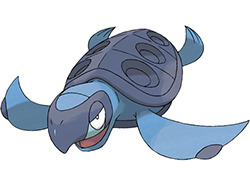
To be completely honest, I constantly forget Tirtouga exists. I think it's because it's Just A Turtle; there's no real clear theme at this stage, and there's not really anything about the design that sticks out other than the lovely gray and blue color palette.
Part of the problem is that while Tirtouga and its evo are based off of extinct giant turtles (Protostega and the massive Archelon, respectively), turtles... you know, still exist in the modern day. And because they still exist, there are a lot of other turtle and tortoise 'mons, like the Squirtle line, Torkoal, Terapagos, the Turtwig Line, etc. Sure, it's technically the only sea turtle 'mon, but that's not enough to inherently differentiate it and make it interesting.
Given the direction the evo takes, I kind of would've liked to see more emphasis on the shell; make it giant and bulky relative to the body, make it extend up over the head, etc. It's nice enough visually, but it really needs something that would make it stand out.
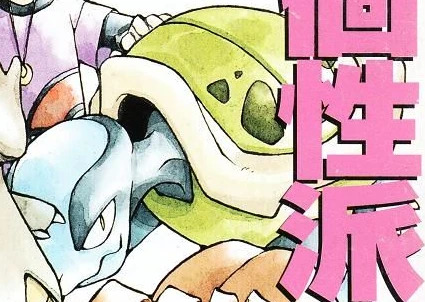
(Fun pointless fact: Ken Sugimori once drew an illustration for a magazine cover featuring a bunch of fake Pokemon-esq creatures, one of which (above) likely became Tirtouga later on. This is probably why it evolves from the "cover fossil". This fact is more interesting than the actual 'mon.)
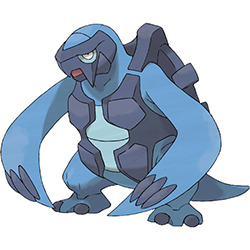
Carracosta has something going for it by standing up and becoming bipedal. This isn't unheard of for either turtle 'mons (Blastoise) or fossil 'mons (Kabutops), but it instantly gives it something distinct and visually differentiates it from its pre-evo.
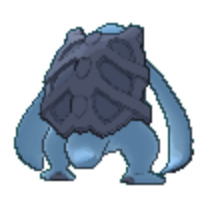
The other thing it has is a very unique shell design, which is segmented like ribs that stretch around the shoulders/legs and doesn't wrap over the stomach. It's likely meant to look like a bullet-proof vest, which is sort of random but it at least pretty cool looking. It strikes me as very classic Gen 1/Gen 2-ish design, despite being a Gen 5 'mon; it's something in the way it stands up and the bony yet somewhat organic shell design that does it.
My only nitpick here is that the ridges on the flippers look out-of-place, as that shape isn't shared anywhere else in the design. It feels like it needed to reuse the bulkly polygonal shapes from the front "vest" to create a pair of brass-knuckle like covers that wrap around the entire flipper. Otherwise, this one's pretty solid.
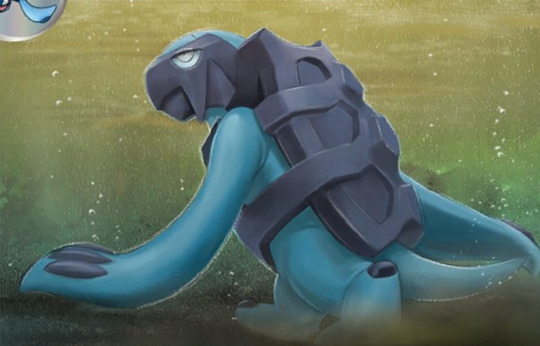
Overall, Tirtouga is too generic for its own good, but Carracosta's pretty neat and has a solid design. There could be room for regionals down the line, if you assume the line adopted to other regions before dying out originally.
50 notes
·
View notes
Text
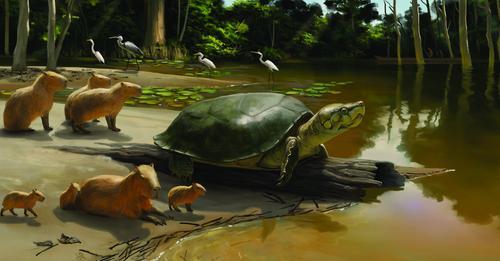
Newly discovered fossil of giant turtle is named after Stephen King novel character
Senckenberg Research Institute and Natural History Museum
An international research team led by Dr. Gabriel S. Ferreira from the Senckenberg Center for Human Evolution and Paleoenvironment at the University of Tübingen has described a new species of giant turtle from the late Pleistocene. Peltocephalus maturin is between 40,000 and 9,000 years old and comes from the Brazilian Amazon. With a shell length of about 180 centimeters, the species is one of the largest known freshwater turtles in the world. The armored reptile was named after the giant turtle "Maturin," a fictional character created by best-selling author Stephen King. With a maximum shell length of 140 centimeters, the Asian narrow-headed softshell turtle (Chitra chitra) together with the approximately 110-centimeter-long South American river turtle (Podocnemis expansa) is one of the largest freshwater turtles alive today...
Read more: https://phys.org/news/2024-03-newly-fossil-giant-turtle-stephen.html
49 notes
·
View notes
Text
Snapping Turtles
Imagine a creature so ancient that it watched the dinosaurs come and go, yet it still glides silently through Ontario’s wetlands today. The snapping turtle, a living fossil, embodies resilience and adaptation in ways that seem almost mythical.
For over 200 million years, snapping turtles have barely changed. Their rugged shells, jagged tails resembling a dinosaur’s, and powerful jaws make them look like prehistoric survivors. But beneath their tough exterior lies a more incredible story.

This is G, a Common Snapping Turtle that was surrendered to the RBG. Due to living his life in captivity, he has not developed the skills he needs to survive in the wild and sadly can not be released.
One of the most remarkable things about snapping turtles is their ability to survive in conditions that would doom most other animals. In the winter, when ponds and lakes freeze over, and oxygen levels drop dangerously low, snapping turtles enter a state called brumation which is a form of hibernation. They slow their heart rate to just one beat every ten minutes and absorb oxygen directly through their skin and cloaca. Yes, they breathe through their butts!
Even more astonishing is their ability to survive without oxygen entirely. For weeks, sometimes even months, they can switch to anaerobic respiration, producing energy without oxygen. However, this comes at a cost, it floods their bodies with lactic acid, the same stuff that makes our muscles burn after intense exercise. But snapping turtles have a secret weapon. Their shells act like giant antacids, neutralizing the acid and keeping them alive until spring.
Their resilience isn’t just physical, it’s reproductive too. A female snapping turtle can store sperm for several years, waiting for the right conditions to fertilize her eggs. When she finally does, she might travel over a kilometer from her wetland home to find the perfect patch of sandy soil to lay her eggs. It’s a risky journey, crossing roads and avoiding predators, all to give her young a better chance at survival. Even after hatching, the odds are stacked against baby snapping turtles. Raccoons, skunks, birds, and even fish are all eager to make a meal of them. Only about one in a hundred will survive to adulthood, but those that do could live for over a century, quietly patrolling their watery domains.

Pictured here are Snapping Turtle hatchlings emerging from a protected nest. This nest contained around 40 healthy turtles!
What’s even more fascinating is the role snapping turtles play in their ecosystems. They are nature’s cleanup crew, feasting on carrion and keeping wetlands healthy by preventing the spread of disease. They’re both predator and scavenger, balancing aquatic food webs with each powerful bite.
Yet despite their toughness, snapping turtles face an uphill battle against habitat loss, road mortality, and poaching. Wetlands are drained for development, roads slice through their ancient migratory paths, and people misunderstand them as aggressive. In truth, they prefer to avoid conflict, only snapping when cornered or picked up, a last-ditch defense as they can’t retreat into their shells like other turtle species’.
The next time you pass a pond or marsh, imagine the snapping turtle beneath the water’s surface, a creature older than the dinosaurs, built to survive the impossible, and still fighting for its place in the modern world. The snapping turtle isn’t just an animal, it’s a living legend, quietly reminding us that nature’s most amazing stories are often the ones hidden in plain sight.
3 notes
·
View notes
Text

Caenagnathids are a family of distinct oviraptorosaurs with longer, lighter, toothless jaws and more slender, gracile anatomy than Ovoraptorids. Until the discovery of Anzu wyliei, remains of Caenagnathids were scarce and fragmentary, especially in North America. But then, in 2014, this giant North American Oviraptorosaur was described. Originally nicknamed the “chicken from hell”, Anzu was instead named after a fire-and-water-breathing bird monster from ancient Sumerian mythology. And, resembling a 3.5–3.75 meter (11.5–12.3 ft) long and 200–300 kilogram (440–660 lb) parrot with a high crescent-shaped crest on its head, Anzu certainly earned its name.
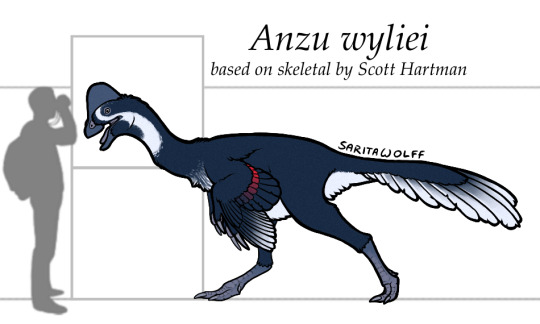
The oviraptorids were smaller and stockier than this tall giant, however, Anzu’s beak was not as heavily constructed as theirs. Like most ovoraptorosaurs, it was likely a herbivore or omnivore, using its beak to crack open hard shells and nuts. And, unlike its desert-dwelling cousins, it lived in lush forests and floodplains, likely with a different set of adaptations for this environment. Anzu’s large crest, the largest of all oviraptorosaurs, was actually quite thin and light, likely used for social signaling and to attrract mates.

Living in the North and South Dakota of the famous Late Cretaceous Hell Creek Formation, Anzu would have lived alongside many of the most familiar North American dinosaurs, including both species of Triceratops, Edmontosaurus annectens, and Tyrannosaurus rex. Aside from the Big Three, Anzu also lived alongside ankylosaurs like Denversaurus, pachycephalosaurs like Pachycephalosaurus, rarer ceratopsians like Torosaurus, and ornithopods like Thescelosaurus. Fellow theropods included Ornithomimus, Acheroraptor, Dakotaraptor, birds like Brodavis and Potamornis, and the slightly smaller caenagnathid Eoneophron. Azhdarchid fossils have been found here as well, possibly belonging to Quetzalcoatlus or a relative. Pseudosuchians lived here too, including Borealosuchus and Brachychampsa, as well as a large variety of turtles and mammals, at least one indeterminate mosasaur, and the choristodere Champsosaurus.

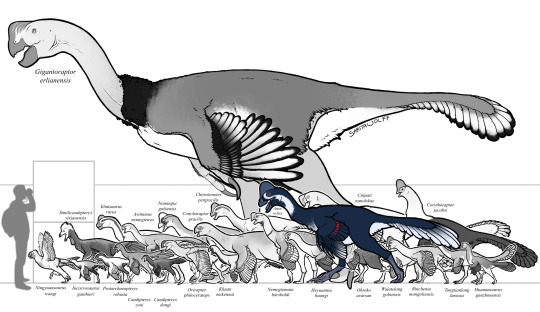
This art may be used for educational purposes, with credit, but please contact me first for permission before using my art. I would like to know where and how it is being used. If you don’t have something to add that was not already addressed in this caption, please do not repost this art. Thank you!
#Anzu wyliei#Anzu#Caenognathid#oviraptorosaurs#theropods#saurishcians#dinosaurs#archosaurs#archosauromorphs#reptiles#SaritaDrawsPalaeo#Hell Creek Formation#Late Cretaceous#United States of America
9 notes
·
View notes
Text
Ethanol and Mothballs
Word Count: 2.1k This short story is inspired by the museum collections that I visited during my January paleontology class. All of the pictures used are mine and were taken at the various museums we visited. I'm super excited to share this story with y'all, and hope you love it as much as I do!

The halls of the museum are quiet. The day has ended, night plunging the rooms into eerie darkness. Gone are the copious beams of sunlight flowing through the windows. They now show only the gray haze of the city's night sky, plunging the marble halls into obscurity. It's the end of the hustle and bustle of tourists, of the cheerful shouts and giggles of children, and more subdued conversations of adults. The darkness is broken only by the flashlight beams of security guards working the graveyard shift.
Occasionally, their light settles on the bones of long-dead animals resting peacefully in their wire armatures, casting odd, distorted shadows across the walls. The umbral forms of prehistoric fossils dance with the shadows of the guards, brought halfway to life only briefly by their light.

The silence is broken only by footsteps on carpet, the whirring of the climate systems, and the building's occasional creak and groan. All is still as it should be; quietly resting after the long day. It would seem that the museum dies at night.
I open my eyes, hearing the slosh of fluid around me as I shakily stretch, limbs hitting the hard edges of my tub. I groan, my voice gravelly from disuse. Finally, it's time to wake up. I sit up, my poorly adjusted eyes only seeing the occasional glint of light reflecting off the trails of ethanol crisscrossing the floor. My muscles are cramped; I barely see my pale limbs tremoring in front of me. I shake, struggling to find a grip on the sterile stainless steel until I manage to grab the edge of the tub. Slowly my eyes adjust to the welcoming darkness, a wonderful reprieve from bright fluorescent lights. The air is thick with the smell of ethanol. Always ethanol here, it clings to everything and everyone, a constant reminder of the place where we reside.
As my vision improves, I can make out the shapes of the shelves in the darkness. They stand in a puddle of ethanol, trails and prints radiating in all directions from it. My tremors slowly subside as my body fights the vestiges of the cold sleep.
I watch a snake slither out of its jar, landing in the ethanol puddle with a quiet plash. It's quickly followed by its jar-mates, then the frogs from the jar next door.
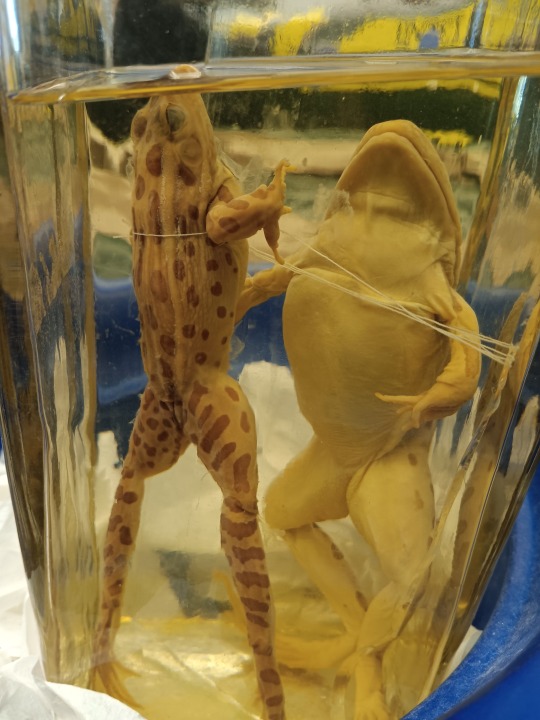
The soft sloshes are interrupted by a loud series of splashes and thrashes coming from a large tub on the far side of the wet lab. The smell of ethanol intensifies as the massive alligator snapping turtle inside sends liquid everywhere in his energetic bid for freedom. I climb out of my tub, walking off the stiffness and the last of the tremors before pulling the turtle out by the back of his shell.
“Happy wake-up, Troy,” I say as he starts to wander around the room, leaving behind a broad, messy ethanol trail. He opens his mouth wide, looking straight at me. I’m never sure if that's his version of a smile or a death threat.
The shelves are alive, undocumented insects trundling among their more well-known friends. One jar spews hundreds of tiny snails as they crawl over each other and to the ground, trailing ethanol instead of mucus. I twist off the lid to another snail jar; this one is always particularly stubborn. As I pull off the lid, a giant African land snail creeps out onto my arm.
“Yeah, alright buddy, we can go for a walk. Stretch your, er, foot.”
Snail crawls up my torso and onto my shoulder. I gently pat them between their eyestalks and scratch their shell.
“Just give me a second to let the fish out,” I say, unscrewing the lids of the fish jars and letting them swim out into my large tub, “Have fun, guys. It's not much, but it's better than being stuck like sardines in a can. Or a jar, I guess.”
Troy the snapping turtle shuffles over to watch them schooling.
“You can't eat anymore, remember? None of us can. Don't try it, Troy.”
He opens his mouth, giving me another smile/death threat.
“Thank you.”
I slide Dr. MacMorgan's I.D. out from under a dusty, overlooked jar of rhino beetles on the top shelf. I'm grateful for the museum's leniency in issuing him a second I.D. after this one went missing. He claimed he lost the thing, after all, his eyes “aren't what they used to be,” and his memory “is full of cotton wool these days.” I think the curator also helped to fast-track the process. She definitely didn't ask many questions.
Anyway, I had a garden snail steal the I.D. so that I could walk around collections. What can I say, I got tired of only exploring when the man forgot it in the piles of paperwork on his desk. Feelings and federal laws don’t matter much when you’re dead. Besides, now I can go check out the new research posters they put on the walls. It's nice to know that they're still using us for something.
I swipe the I.D. and step into the hall. The smell of ethanol fades as the door to the wet lab closes. Snail crawls onto my head for a better view as I step into the bathroom and look at our reflection. The light turns on automatically as I walk in, and I wince as my eyes struggle to adjust. I look at myself in the mirror; my cheeks are sallow, cloudy eyes sunk into yellowed skin. A little worse for wear, but not bad, I haven’t aged a day. I examine my arms, running my fingers over the relatively new needle-hole in one of them. It showed up a few months back, but it’ll never heal. Presumably, it was for a tissue sample; I wonder what they’re using it for. I have been dead and pickled in ethanol for a while, it was about time. Snail (who I seem to be wearing as a hat) looks a little better-preserved, but their body still has that yellowish color that all wet lab residents tend to get. My snail hat waves their eyestalks towards the door emphatically.
“Okay, okay, I’m going!” I say, stepping back out of the bathroom and into the darkness of the halls. “Where to now?”
They crawl down to my forehead, waving their left eye stalk in front of my eye.
“Alright, fossils it is. I know you like the shark teeth.” They do a move resembling a one-snail wave in appreciation. I smile, heading through the maze of nearly identical corridors. I see the light of a flashlight ahead and duck into an empty office, narrowly avoiding someone. It's probably just a grad student returning from the vending machine with their energy drink. I wait until the light is gone and slip back into the halls.
“Hey look! They extracted my DNA and used it to do some stuff. That explains the needle hole in my arm,” I say, pointing out a poster on the wall. I step close so that Snail can read it. At least, I think they can read. Their eyestalks scan over the lines of text and appear to understand as they pull back.
They settle back on my forehead and I set off once more, finally reaching the thick, heavy door to the fossil collections. I scan the I.D. and the light blinks green, letting me in beyond the large gray door. We are hit with the strong smell of mothballs and the crisp, strictly temperature and humidity-controlled air. The lights turn on automatically, illuminating the rows of open shelves and closed metal cabinets.
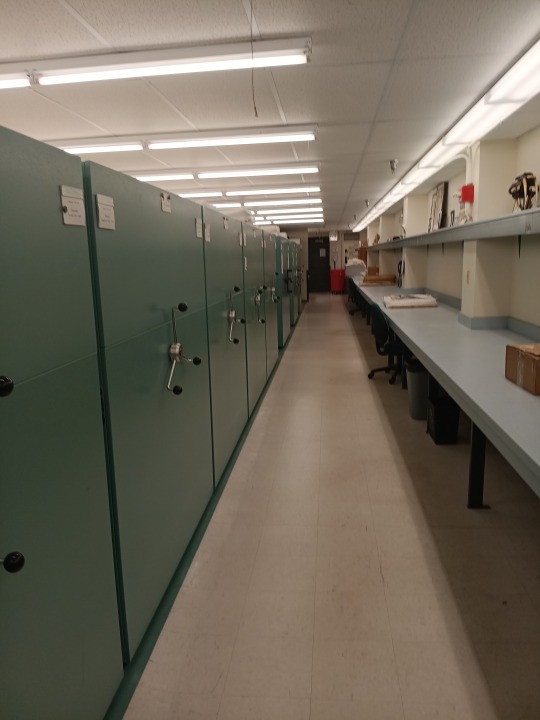
I walk down the aisles, waiting for Snail to stop me and gesture to whatever cabinet they find interesting. When they do, I open the door. All of the drawers are labeled “glyptodon,” so I pull out a random one. Snail crawls off of me and onto the cabinet, eye stalks investigating the giant armadillo fossils. Mostly osteoderms, the bony bits right under the skin, but some teeth and small bones. When they’re satisfied, I close the cabinet and open a nearby one.
We proceed in a similar fashion for a while, opening whatever cabinets strike our fancy and stopping to admire the fossils inside. Snail crawls back onto my head and we look at the skulls that rest on the open shelves. There are plenty of mammoths and mastodons, recognizable by their massive teeth. The mammoth teeth are more flat, while mastodons’ are more pointy unless they’ve been worn down a lot.

I run my hand along the glossier fossilized enamel, wondering what the fossils would get up to if they could move around at night. They’re just rock-ified bones (the fancy descriptor is permineralized), so they’d fall apart, assuming that they hadn’t already. The Earth is a blender, or so I hear.
Snail prefers the smaller fossils, so they’re content to stay on my head as I trace the contours of huge tusks, dino bones, and skulls. It’s crazy to think that some of this stuff is still closer in age to spaghetti than to the beginning of life. It sure seems like it’s been fossilized for ages. And then some paleontologist dug it up and encased it in plaster and a volunteer put in thousands of hours to clean it up.
“Having a nice wander?”
I jump, snapping abruptly out of my thoughts. The voice comes from behind me. Snail retreats into their shell, still on top of my head. Act like a normal person. One who hasn’t been dead and preserved in ethanol for fifty years.
“Hi! I uh, have a really bad skincare routine!”
She laughs. I turn around. It’s the museum curator. She’s wearing a headlamp; it’s still turned on. She raises a hand to turn it off since it’s not needed in the automatic lighting of the fossil collections.
“That tends to happen when you’re a wet lab specimen.”
“You know about that?” I ask as Snail peeks out of their shell, eyestalks fixed on her. The curator’s gaze tracks up at them, then back to my cloudy eyes.
“Yes. How do you think MacMorgan got a new I.D. so quickly?” Seeing my look of concern, she adds, “I don’t mind if you leave the wet lab, as long as you don’t make a mess.”
“Uhh… okay…” I say, still trying to process the new turn of events.
“Some people think that this building is haunted. I see why they would say that. I passed you in the hall earlier, you look very sinister,” she says, smiling.
“That was you, with the light? I thought it was a grad student! Dammit, I need to be more careful,” I reply, looking perturbed.
“You could, or you could keep letting the world believe that this building is haunted.” The curator seems to be enjoying this conversation. She reaches out a hand to pet Snail’s shell. After a few moments, she speaks again, “It can be our little secret.”
“You’re not scared by me? I’m literally dead and pickled, how are you fine with this?”
She laughs again. “I used to work in a wet lab, I’m quite accustomed to seeing preserved organisms. And if you want to have a little fun at night, I suppose I can continue to turn a blind eye.”
I nod awkwardly, surprised by her casual demeanor. The curator holds out her phone, the screen showing a clock that reads 4:13 a.m.
“For now, it’s time to go back to bed,” she says as the screen turns off. I stare into my reflection in the black glass.
“Yeah. Yeah, I’ll get back to wet lab,” I say, realizing that I’m starting to feel the sluggish feeling that heralds in the morning.
She smiles, turning her headlamp back on as we leave the fossil collections. The curator walks off, disappearing into the shadows of the halls as Snail and I hurry back home. I swipe the I.D. and duck inside, stopping for a moment as I’m hit with the strong smell of ethanol. I help Troy back into his tub, coax Snail into their jar, and gather up the fish swimming in my tub. We’re all much more sluggish as the morning starts to roll in, seeing the sky start to lighten through the window. At last, I collapse back into my tub, trying not to splash too much as I let the ethanol settle back around me.
I drift off into the long day, holding on to the memories of the night. My cloudy eyes don’t close as my muscles stiffen, ready to stay motionless for the next day in the bright lights of the lab. I could run these halls forever, reveling in the shadows of forgotten, forever preserved lives, permeated in the scent of ethanol and mothballs.

#writing#creative writing#short story#female writers#writers on tumblr#writerscommunity#writers and poets#writeblr#writblr#paleontology#biology#ethanol#museum#museum photography#science#mothballs#museum collections#fossils#field museum#wet lab#laboratory#dinosaur#t rex#mammoth#prehistoric animals
12 notes
·
View notes
Text
What Are The Types Of Living Reptile Fossils?
Reptiles, an ancient and diversified animal order, have left a fascinating fossil record that sheds light on their evolutionary history. Fossils provide a glimpse into the distant past and aid in explaining the various varieties of reptiles that previously walked the world. These prehistoric relics have survived in various forms, allowing paleontologists to classify living reptile fossils. Each type of living reptile fossil, from the fearsome dinosaurs to the gorgeous sea reptiles and the forefathers of present reptilian species, tells a distinct story of adaptation and survival. In this writeup, we will explore and learn about them.
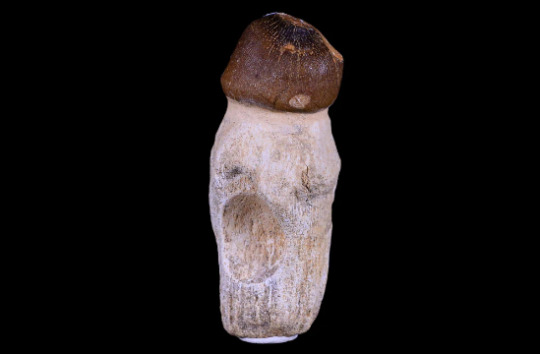
Learn About The Types Of Living Reptile Fossils
Reading the below pointers, you will find information about the different types of living reptile fossils.
1. Dinosaur Fossils
Dinosaur fossils are the most famous and captivating examples of living reptile fossils. These ancient giants once dominated the Earth during the Mesozoic era. Fossilized bones, tyrannosaurus rex teeth, and even footprints provide crucial information about their anatomy, behavior, and ecological roles. They are classified into various groups. For example, sauropods, theropods, and ornithischians exhibit distinctive characteristics and adaptations.
2. Plesiosaur And Ichthyosaur Fossils
Plesiosaurs and ichthyosaurs are iconic marine reptiles from the Mesozoic era. Plesiosaurs had long necks and large flippers, while ichthyosaurs had streamlined bodies resembling modern dolphins. Fossils of these sea-dwelling reptiles have been discovered in various parts of the world, revealing their aquatic lifestyle and evolutionary traits.
3. Pterosaur Fossils
Pterosaurs were flying reptiles that were in existence during the Mesozoic era. Fossils of their impressive winged structures, known as pterosaurs, provide insights into their flight mechanics and adaptations for aerial life. These reptiles were the first vertebrates to achieve powered flight, and their fossils showcase a wide range of sizes and shapes.
4. Mosasaur Fossils
Mosasaurs were powerful marine reptiles that existed during the Late Cretaceous period. These apex predators were adept swimmers due to their lengthy bodies, powerful jaws, and well-developed flippers. Mosasaur fossils have been discovered in marine sediments, demonstrating their importance in ancient marine ecology.
5. Archosaur Fossils
The archosaurs are a reptile class incorporating dinosaurs, pterosaurs, and crocodilians. Their fossils give a total image of the developmental connections between these reptilian taxa and their normal predecessors. They provide critical evidence to decipher these ancient creatures' common features and characteristics.
6. Crocodilian Fossils
Crocodilians, including alligators, crocodiles, and caimans, are living reptiles traced back to prehistoric times. Fossilized remains of their ancestors provide insights into their morphological changes and adaptations throughout geological ages, revealing the history of their survival and diversification.
7. Turtle Fossils
Turtles are ancient reptiles with a unique bony shell covering their bodies. Turtle fossils dating back to the Triassic epoch have been discovered. These fossils have been crucial in understanding turtles' evolution and their characteristic shell formation.
8. Snake And Lizard Fossils
The fossil record of snakes and lizards provides essential evidence of their evolutionary history and adaptations. Fossilized snake skeletons have shed light on the transition from limbed to limbless forms, while ancient lizard fossils have revealed the diversity of these creatures in prehistoric ecosystems.
Looking For Authentic Reptile Fossils? Reach Them!
Fossil Age Minerals is a well-known company that collects prepares, and sells high-quality reptile fossils and minerals. With a passion for paleontology, they provide a comprehensive variety of ancient reptile fossils from well-known geological formations worldwide, including dinosaurs, pterosaurs, and marine reptiles. Their expert team ensures each specimen's authenticity and scientific significance, making them a trusted source for collectors, educators, and museums. Committed to preserving Earth's prehistoric heritage, Fossil Age Minerals provides a unique opportunity for enthusiasts and researchers to own a piece of history, unraveling the mysteries of ancient reptilian life through their remarkable fossil collections.
0 notes
Text
Carlos is an absolute unit.
[Text ID:
Posted by u/Dev-98 on reddit
"Fossils of a turtle the size of a car have been unearthed in South America. Carlos for scale."
South American man, presumably at least 5' tall, laying down on his back next to a rocky-looking, mostly intact, giant turtle shell, which is belly side up and which dwarfs the man -- his head is even with the bottom of dip of the neck of the shell, the crests of which extend perhaps two feet further above his head, and his feet reach about two-thirds of the way down the rest of the shell.
Response by user Admiral_Fall:
"Carlos is a standard unit of measurement."
/end text ID]

57K notes
·
View notes
Text
fell asleep wondering how body disposal would work in a world were humans evolved more like turtles or giant clams, and had a thick carapace, huge and tougher than our current skeletal system. imagine how inconvenient it would be for a murderer trying to get rid of a body--how do u dispose of the giant fucking shell? also coffins would be a different shape, more like an ellipsoid? human skeletons usually take less than a century to disintegrate, but imagine if we had a exoskeleton that was prone to fossilization. the study of archeology would be very, very affected. also i assume we wouldn't be able to sleep on our backs anymore? how would beds be shaped. what would a world run by turtle-humans look like. would we cover our shells with fabric/clothing or decorate them like we do fingernails? or just straight up do airbrush art? would graffiti be a social issue? someone spray paints u while you're sleeping and u have to pay to have your shell professionally sandpapered? there are so many sociological implications
these are the thoughts that come to me at night
#apparently it takes most people less than 20 minutes to fall asleep.#I want. to hunt those people for sport.
10K notes
·
View notes
Text
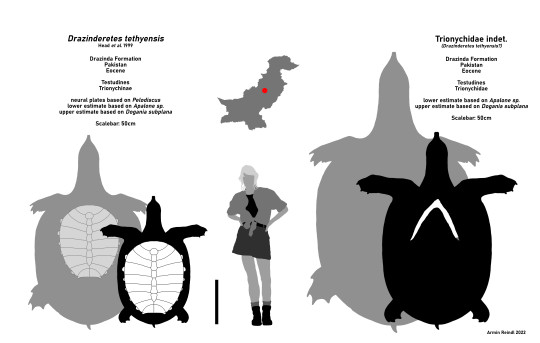
Back to older art. These are giant softshell turtles found in the Eocene Drazinda Formation of Pakistan. On the left is Drazinderetes (Greek for Drazinda Rower), known from a bony carapace 0.8 meters long. On the right, an indetermined softshell turtle that may or may not belong to the same species, but is only known from a plastron element. This might correspond to a bony shell 1.2 meters long. As you can see there are some big difference between the lower estimate and the upper estimate, which has a lot of free space. This is because in different softshell turtles there's difference ratios between the bony and the soft shell parts. The lower estimate is based on Apalone softshell turtles, which have only 20% cartilage on the shell, while the upper is based on the Malayan softshell which has up to 45% cartilage in addition to the bone. First image Apalone ferox (Florida softshell) by Johnskate17 on Wikimedia Second image Dogania subplana (Malayan softshell) by Wibowo Djatmiko on Wikimedia
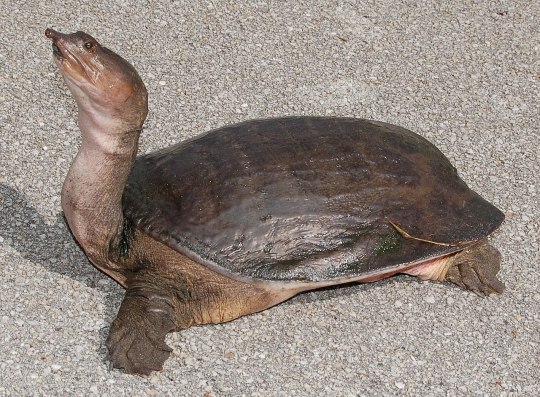
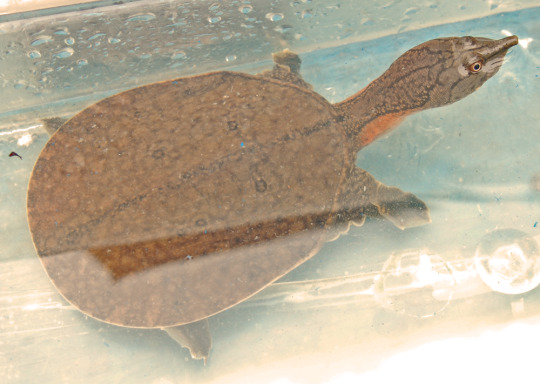
Drazinderetes lived during the Eocene in what is now Pakistan in the Drazinda Formation. This is interesting as this formation preserves a marine environment, meaning that in the absence of evidence that the fossils were washed out at sea, Drazinderetes might have been a marine animal. This would match its enormous size, as most giant turtle species have been marine (not counting those of Miocene South America). Although this would make it the first known fully marine softshell until evidence of the contrary is found, modern softshells are known to occasionally enter saltwater. Drazinderetes shared its environment with crocodiles similar to Asiatosuchus, early manatee relatives in the form of Protosiren and primitive whales related to Basilosaurus. The following reconstructions have both been made by @knuppitalism-with-ue during his paleoart streams.
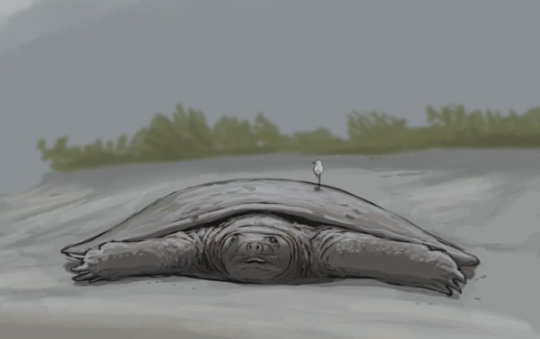
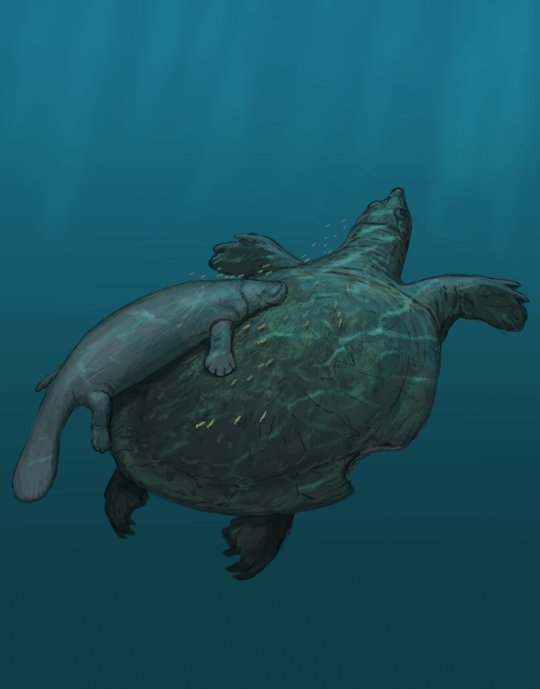
#drazinderetes#softshell turtle#eocene#palaeoblr#paleontology#turtle#drazinda formation#pakistan#skeletal reconstruction#skeletal#size comparison#palaeontology#big fucking turtle
347 notes
·
View notes
Note
I fricking love your dark au just hooked me like a fish out of the water. And it's got me thinking how would all the dark Bois react if say reader was dino mutant ? Like since In the show a garden guy touched a plant and got mutated would that mean maybe touching ancient fossils do the same ? Can be any dino you want :). Ps wishing you nothing but good days and vibes remember to take breaks ,eat and drink water also sleep! Don't pull a Donnie
Okay! So, I made the reader a Siamosaurus which is this (yeah, it's related to the Spinosaurus)! you don't have to keep the colors, make them whatever u want!!!
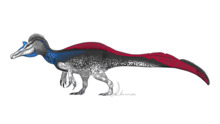
~~~~~~~~~~~~~~~~~~~~~~~~~~~~~~~~~~~~~~~
Similar to the Bat reader who is endangered, a Dinosaur reader would get Draxum's attention, except intensified 200x
Now, you’re a lot more dangerous than other mutants, Draxum realizes this.
Sending all four turtles probably wouldn’t be too effective, so he hired five foot clan members to help the turtles
When the turtles find you, they hesitate for a minute
YOU. ARE. MASSIVE.
You’re at least 7 ft tall, 8-inch talons, large, serrated teeth that look like they would make quick work of cracking a turtle's shell
The turtles and foot clan warriors attacked you quickly, they weren’t fools, having all of them attack you unsuspecting would definitely work in their favor.
However, what they didn’t expect is for you to bolt to the river and hide in it
Even if turtles are decent swimmers, they would be out of their element by whole-ass MAGNITUDES.
The minute a foot clan wades in the water is when you strike, similar to an Alligator or Crocodile, you crush them between your jaws and drag them deeper into the water, the only remains that there ever was a foot clan member was blood tainting the water red
Everyone hesitates, none of them want to go into the water, it was a death sentence, they weren’t the sharpest other than Donnie, but they weren’t stupid either
Donnie switches through his Bo staff, turning into a tranquilizer gun, however, he doesn’t have bait
Looking over at the foot clan members, he makes an executive decision, grabbing one of them and tossing them into the river, causing you to strike at them
Donnie takes aim and shoots you with the tranq dart, causing you to thrash wildly
Donnie signaled Raph to muzzle you with rope, which he quickly did, struggling a bit due to your thrashing
You ended up succumbing to the Tranquilizer a few seconds later, passing out
Waking up later was wild, there was this giant goat bastard who looks like he was trying to badly cosplay as Baphomet.
Growling at him, you flared the feathers on your head, trying to get up but feeling resistance, your neck, muzzle, and tail were secured with metal restraints
He seemed to scoff, the two gargoyles on his shoulders seemed to stare at you in disbelief.
“You are an odd specimen, I knew the Mutagen would mutate people into plants, but never extinct creatures!” you snarled at his words, thinking about all the ways you would mutilate and dismember this fucker
He walked around you before stopping, you glared at him, before he jabbed you with a syringe, you started thrashing, attempting to get out of the restraints, even if it was just your tail that was freed, you would see it as a win
Luckily your legs and arms weren’t restrained, so you forced yourself up, causing your neck restraint to creak before it broke off at the bolts, Draxum stepped back in shock, marveling at your strength
You were able to slip your muzzle restraint off, due to it not being tight, allowing you to open your mouth a bit, the only thing that made it so you couldn’t slip out of the muzzle and thrash your head around was the neck restraint, you snapped over to your tail restraint and bit it off
Getting up, you eyed Draxum up and down, He, seeming to understand the dire situation that was unfolding, started summoning those weird pink vines to capture you again, you were quicker though, bolting off and running out of his lair
Running right back into those four turtles.
They looked at you for a second, as if trying to verify that you were real and snapped into an attack position
You snarled at them, looking at your options, you were surrounded by two sides, however, the water around Draxum’s lair seemed to be a decent way out, you breathed in deeply and jumped into the deep water, swimming down into the watery abyss, the water was warm, but not boiling.
Draxum, Leo, Donnie, Mikey, and Raph looked into the water before Donnie made his usual smartass comment
“I am NOT going into the water to get that thing back” Draxum nodded, he was told about how deadly you were in the water, how you singlehandedly took out two high rank foot clan members before Donnie subdued you.
“Find him later, then” Draxum replied bluntly, before walking back into his Laboratory ~~~~~~~~~~~~~~~~~~~~~~~~~~~~~ Not my finest work but I tried ;v;
#rottmnt x reader#rottmnt#rottmnt headcanons#Dark! ROTTMNT AU#Fae Being a Dumbass#Chaotic Goblin Fae#donatello#raphael#michelangelo#leonardo#baron draxum#the foot clan
186 notes
·
View notes
Photo
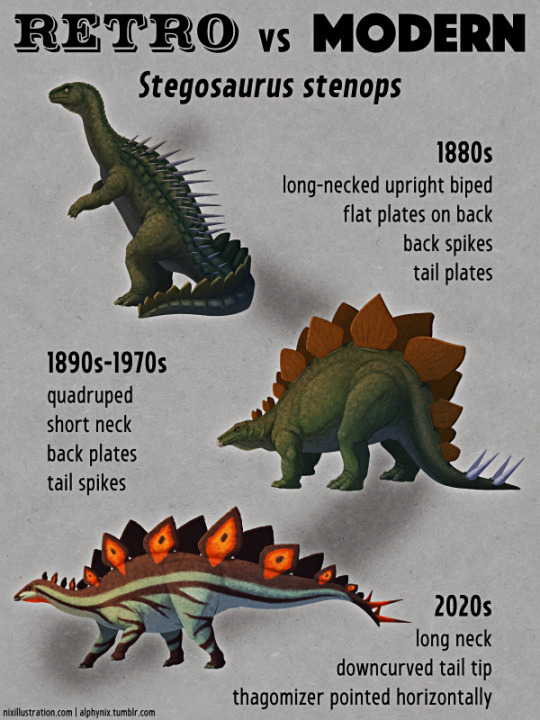
Retro vs Modern #13: Stegosaurus stenops
The first known stegosaur fossils were found in England and South Africa between the 1840s and 1870s, but these dinosaurs weren't properly recognized as a highly distinctive group until the discovery of Stegosaurus itself in North America during the late 1870s.
1880s
The first Stegosaurus reconstructions were based on fragmentary and disarticulated fossil material, and its life appearance was very poorly understood. Initially it was depicted as a bipedal long-necked animal, with its plates laying flat against its back like a turtle shell, numerous spikes across its back, and more plates running along its tail.
1890s-1970s
Better skeletons of the species Stegosaurus stenops were discovered in the late 1880s, and by the 1890s stegosaur anatomy was becoming clearer. Reconstructions quickly adopted an arch-backed body shape with a tiny head and drooping tail, short semi-sprawling forelimbs and long hindlimbs, and with the plates now properly upright on the back and the spikes at the end of the tail.
Stegosaurus' unique appearance rapidly made it one of the most famous and recognizable dinosaurs to the general public. Its comical-seeming tiny head and even tinier brain also unfortunately ended up contributing to the prevailing early 20th century attitude that dinosaurs were sluggish and unintelligent, with the myth that it needed a "second brain" in its hips to control its huge body becoming a popular notion for quite some time.
The exact arrangement of the iconic back plates and tail spikes was uncertain for several decades, with early versions in the 1890s having up to eight tail spikes and a single row of plates. This was then updated in the 1900s to a double row of symmetrical plate pairs, and by the 1920s the standard arrangment had soon become an alternating two-row pattern with the tail spikes reduced to four – a layout that's still considered correct today.
2020s
In the second half of the 20th century a combination of numerous new stegosaur species from China and the Dinosaur Renaissance began to revise the way Stegosaurus was understood, bringing it into a fully upright posture with its head and tail held high, and recognizing the convergently sauropod-like anatomy of its hands and feet.
But something still wasn't right.
Compared to other known stegosaurs, Stegosaurus itself was starting to seem… rather weird. Its short neck, short forelegs, giant plates, sloping back and high rump were much more exaggeratedly proportioned than any of its relatives.
This was finally resolved in the 2010s when a near-complete specimen nicknamed "Sophie" was thoroughly described – and revealed that Stegosaurus' proportions had been wrong the whole time. All previous skeletal reconstructions had been composites, put together from remains of multiple individuals that had all been different ages and sizes, and in the process had heavily distorted our idea of what this animal actually looked like.
Our modern view of Stegosaurus is now a much more typical stegosaur than before. It lived during the Late Jurassic, about 155-145 million years ago, across the Western and South Central United States (with a possible additional occurence in Portugal), alongside several other iconic dinosaurs of the "Jurassic savanna" like Brontosaurus, Diplodocus, and Allosaurus.
It grew up to around 9m long (~30ft), and had a small head with a long narrow snout, with a toothless beak at the front of its jaws and small peg-shaped teeth further back. Bony ossicles lined the underside of its neck, possibly providing chainmail-like protection to its throat, and its skin was covered in tiny pebbly scales interspersed with "rosettes" formed around slightly larger oval scales. Its neck was longer than previously thought, more in line with other stegosaurs, and its torso and hind legs were a bit shorter, making its posture more horizontal and its back less arched.
The actual function of the large back plates is still uncertain. Ideas about them being defensive armor (and speculation about them even being moveable!) have mostly been discounted at this point, since they were actually relatively fragile – although their keratinous covering may have had a fairly sharp edge. Thermoregulation has been a popular explanation for many decades, with blood vessel impressions in the plates being proposed as evidence they were used as "radiators" to prevent overheating like the ears of modern African elephants.
But currently the most likely primary plate function is thought to be visual display, with the large plates increasing the perceived size of Stegosaurus either to intimidate predators and rivals or to impress potential mates. If this was the case then they may have also been strikingly colored and patterned in life.
Meanwhile the "thagomizer" on its tail actually does seem to have been a weapon, with injuries to that area of the body being fairly common, and several Allosaurus fossils have been found with puncture wounds the exact size and shape of Stegosaurus spikes. Articulated specimens have also shown that the tail curved downwards at the tip, holding the thagomizer with the spikes pointing horizontally outwards and backwards.
———
Nix Illustration | Tumblr | Twitter | Patreon
#retro vs modern 2022#science illustration#paleontology#paleoart#palaeoblr#stegosaurus#stegosauridae#stegosauria#stegosaur#thyreophora#ornithischia#dinosaur#art#retrosaurs#i personally like the idea of eyespots on the plates#just rows of giant eyes staring at you
3K notes
·
View notes
Photo

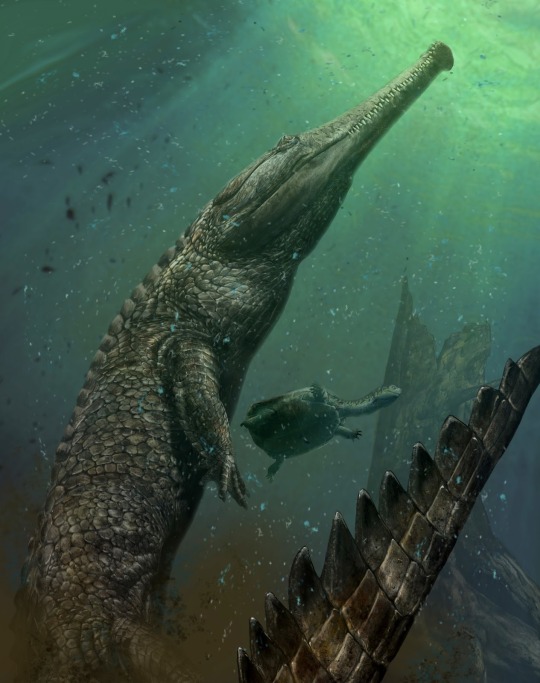
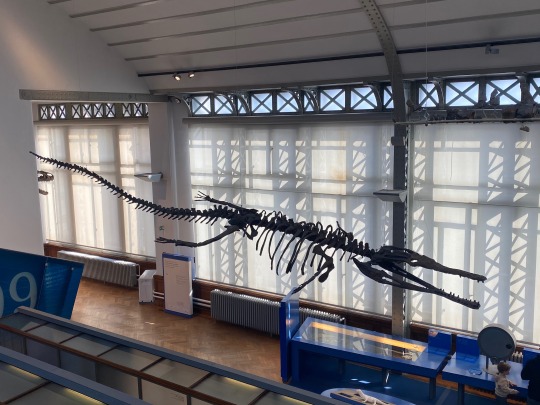
This is Machimosaurus, an impressive crocdile-like Jurassic predator from our Evolution Gallery !
Machimosaurus is a crocodyliform of the Teleosaur family, which ruled the seas and oceans from the Upper Jurassic to the Early Cretaceous.
Members of the Teleosaur family were initially more slender, with a much longer snout efficient at catching smaller preys such as fish. However, over time, Machimosaurus evolved to become particularly larger than its relatives, with a slightly shorter snout.
Semi-aquatic, Machimosaurus was able to venture ashore to hunt. However, this exceptional swimmer was a master of deep-sea hunting. In the water, it used its short legs to steer and to keep balance, while its robust tail allowed Machimosaurus to propel itself.
Other distinguishing features of this species were its massive skull and long snout. Using its conical, rounded teeth and an overpowering jaw force, Machimosaurus was able to target larger or shelled prey: fish, turtles and other marine reptiles, as well as some overly adventurous terrestrial species had to be especially cautious of this fierce predator.
Fossils of this 100-million-year-old giant have been discovered in several countries across Europe and Africa. These findings have allowed palaeontologists to separate, to this date, the lineage of Machimosaurus into five probable species.
One of these, the Machimosaurus rex recovered from a desert in Tunisia in 2016, could be the largest member of this lineage. According to various estimates, this animal could have grown up to more than 7 metres in length, for 3 tonnes: not the kind you'd want to meet in a face-off!
[Picture by visitor Merle Van Faassen, and Machimosaurus Rex illustration by Davide Bonadonna]
#naturalscience#naturalsciences#natural history#natural history museum#machimosaurus#jurassic#cretaceous#museumvisitor#naturalsciencesbrussels#royal belgian institute of natural sciences
50 notes
·
View notes
Link
A mermaid.
A merman.
A shark with 2 heads and tentacles where its tail should be.
The net has been chewed through.
A skeleton with different gold bones.
A school of singing fish.
The tentacle of a kraken.
A bunch of crabs with weirdly shaped claws. Some look like they have hands, paws, knives, trident, etc.
A kraken toddler.
The kid of a mermaid & merman. Around 6 or 7 years old.
A 20ft. white lobster.
A severed ear with an attached golden earring.
A message in a bottle.
Dragon-turtle egg.
A poisonous fish that deals 1D8 damage when eaten.
A school of quippers.
A locked chest.
Fragments of a wrecked vessel.
Eggs of a Sahuagin.
A coral/barnacle-encrusted magical weapon/armor.
A concrete block with the remnants of two humaniod legs sticking out. If the players break the concrete, a ring of waterbreathing can be found on one of the toes. Kinda makes you wonder how the person died if it wasn’t by drowning….
A ships intricately detailed figurehead.
A chum bucket.
A pineapple with a sea snail crawling all over it.
A lobster trap containing a crab, a squid, a sea sponge, and a starfish.
A glass ball containing a live squirrel.
A broken leg bone.
A letter in a bottle. Written on the letter is a recipe for a very delicious sandwich.
A painting of a pirate and his parrot.
A bloated corpse that looks exactly like you.
The net is empty, but coated with gritty, pitch-black oil.
A perfectly intact but not fossilized dead animal that has been extinct for millennia.
A fist-sized, segmented black metal pyramid that causes everyone around it to vie for possession of it with increasing violence unless it is submerged in salt water.
A skull of the fishman species with noticeable gouges and cuts around the eye sockets.
Driftwood.
The most beautiful piece of driftwood you’ve ever seen.
A rune-covered iron flask sealed with a silver band.
A wooden doll without clothes.
A grapefruit sized stone sphere that mysteriously floats in salt water.
A key carved from bone.
A fine/expensive looking cloak that hasn’t begun to rot yet.
A large cod. (Gold ring in its stomach)
A scroll case with a now-indecipherable treasure map.
Your net is torn from your hands: a DC 25 perception check from on the ship, or a DC15 from in the water, reveals an immovable rod that it got caught on.
A sentient jeweled necklace which appears to be worth several thousand gp but tries to convince the wearer to kill themselves.
An ornate wooden statue of some god or goddess, now covered in barnacles.
A bottle containing one copper piece and a note reading “spend it well”. The coin is too big to leave the bottle.
A sleeping human girl wearing barnacle/seaweed covered clothes that look incredibly old. Once she is relatively dry, she wakes up.
A strange stone tablet with a map etched on it, and writing in Aquan.
A live crab, but made of solid gold and encrusted with gems.
The anchor of a legendary pirate vessel.
A talking fish that offers to grant a wish in exchage for being set free.
A rusty sword that seems to glow, but only when you look at it from the corner of your eye.
A carved stone talisman on a broken cord, tangled in seaweed.
A bottle of rum.
An ancient bottle of wine, encrusted with barnacles.
A brass oil lamp – maybe you should try rubbing it clean…
1d8 spiky green fruits. It will cause you to vomit sea water (and just sea water) if you eat it.
A golden compass and astrolabe.
A sea-elf offering slightly damp sea scrolls for sale. Very handy during storms.
Giant 30ft. clam. 50% chance for a pearl.
Giant lobster being ridden by a sea goblin.
A talking sea turtle.
A reverse mermaid. (Top half fish and human legs).
A bottle with a (d100)potion inside.
A school of fish that cause hallucinations when consumed.
A giant 25ft oyster. Cracking it open reveals a Sea Dragon egg instead of a pearl.
A chunk of meteorite that fell into the ocean.
A glass helmet that grants darkvision and waterbreathing.
A trident.
A shipwrecked sailor.
The leftovers from a sauhaugin attack.
Large orbs that appear to be made of pure water, which are slightly gesticulating (an aquatic variant of gelatinous ooze).
A baby in a basket (race can very based on DM descretion).
A pirates peg leg. Made of two parts, a wide brim that attaches to the leg and the actual peg. Unscrewing it reveals the leg is hollow, with a map on the inside.
A Demigod who had one too many to drink. Return him to their dad to get a reward.
A shackled live Triton.
Several large pieces of perfectly polished sea glass.
An old boot mimic.
A bag of coins from different civilizations, not all of them are from recent civilizations, but all of them are covered in a black, viscous ooze.
A clam that’s sealed shut, with an unbreakable shell. If the shell is pried open, the clan starts signing sea shanties in the wrong key – very, very loudly.
A bottle with a map in it.
An entire campfire, still lit, that doesn’t burn anything.
A small red crab that speaks fluent Common with a melodic accent. Once in the boat it demands to be placed back under the sea.
A barnacle clad silver hand mirror, miraculously still intact. When you try to look at your reflection, you see yourself as a bloated dead corpse.
A sealed container with an important letter inside.
An odd & very fancy looking coffin that is sealed.
A sextant made of coral, covered in kelp.
A harpoon.
Gold coins that are (20d10 x 100) years old.
A whale screaming bloody murder.
The eggs of a kraken.
A very large squid. Could easily be mistaken for a kraken.
The skulls of Giants. 8 to be precise.
The Kraken
A shark with half-formed legs.
A shell inscribed with runes (a mermaid’s love poem).
A giant that was out for a swim. He got tangled in the net.
An octopus with a knife and a salty look in her eye.
A mysterious egg that doesn’t belong to any known species.
#d20#rpg#dnd#dungeons and dragons#fantasy#sword and sorcery#campaigns#fairy tale#mythology#fable#dungeon master#dm#game master#gm#hackmaster#magic item#magic weapon#magic ring#spell book#d12#d10#d8#d6#d4#d100#dice
21 notes
·
View notes